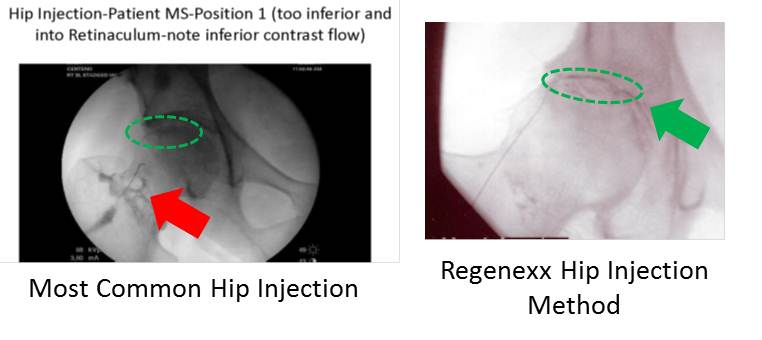Hip Stem Cell Injections-Are the Cells Getting where they Need to Go?
Awhile back I blogged on the “blind” hip stem cell injection that a patient with severe hip arthritis had received in a Mexican clinic. Getting stem cells into the hip joint reliably without imaging guidance (fluoroscopy or ultrasound) is like driving your car to the store with black spray paint on the windows-you might make it there safely and you might end up crashing. Even with imaging guidance, the most common hip injection technique is to place the medication low in the joint, near the femoral neck (see picture on the left above-note that the needle and dark contrast are low in the joint at the red arrow while the green dashed circle denotes the location of the arthritis). This method developed because it was easy for the physician and the goal was to simply park the medication somewhere in the joint. Several years ago we began to notice that in many patients, this technique would sequester stem cells in the lower portion of the joint and that stem cells would therefore have a hard time making it into the upper joint (where the arthritis lived-green dashed circle on the pictures above). As we saw others publishing data that where cells are placed in a joint can significantly impact outcome, we decided to perform our own cadaver injections and dissections. We soon learned that there was a little known “pouch” where the stem cells could get trapped when this most common hip injection method was used-the “Retinaculum of Weitbrecht”. You don’t often hear about this obscure piece of anatomy, but it now became a major concern for us. As result, we had to reinvent new ways to inject stem cells into the hip, using both ultrasound and fluoroscopy so that we could get cells to the upper area of the joint where our patients had arthritis (see picture above right with green arrow). You can imagine, with all the care we take to get cells to the right spot that hearing that we’re still seeing hip joints being injected with stem cells without guidance is troubling. Even with guidance the cells are still often placed in the wrong area. The upshot? If someone wants to inject stem cells into your hip joint and is planning on doing this without any guidance or doesn’t have a plan on how the cells will make it to the upper joint-run.

If you have questions or comments about this blog post, please email us at [email protected]
NOTE: This blog post provides general information to help the reader better understand regenerative medicine, musculoskeletal health, and related subjects. All content provided in this blog, website, or any linked materials, including text, graphics, images, patient profiles, outcomes, and information, are not intended and should not be considered or used as a substitute for medical advice, diagnosis, or treatment. Please always consult with a professional and certified healthcare provider to discuss if a treatment is right for you.
